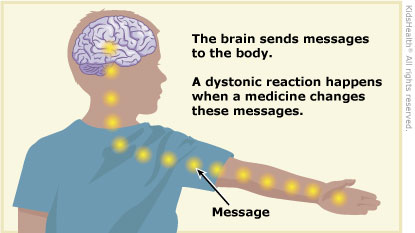A dystonic reaction is a type of side effect that can happen from certain medicines. It causes uncontrollable tightening, twisting, or moving of muscles. A dystonic reaction happens because the medicine causes chemicals in the brain to get out of balance. The imbalance changes the messages that the brain sends to the muscles.
Health care providers treat dystonic reactions by stopping the medicine they think is causing the reaction and giving medicines to help with the symptoms. Here's some information to help you care for your child at home.


Follow your health care provider's instructions for:
Other tips:



What medicines can cause dystonic reactions? Some medicines for nausea and vomiting, seizures, or psychiatric illness (such as depression or psychotic disorders) can cause dystonic reactions. Some street drugs (like cocaine or ecstasy) also can cause dystonic reactions.
What happens during a dystonic reaction? Dystonic reactions often involve muscles of the face or neck, but they can also affect the arms or legs. A child having a dystonic reaction has a hard time controlling their muscles. Parts of the body may twist into unusual positions. They might have trouble speaking or swallowing, or they may make strange movements with their eyes or tongue. Rarely, spasms can happen in the throat and lead to trouble breathing. Dystonic reactions can be painful and very upsetting.
Kids, teens, and young adults are more likely to have a dystonic reaction than older adults. Signs can start soon after taking the medicine or may not start for hours or days.